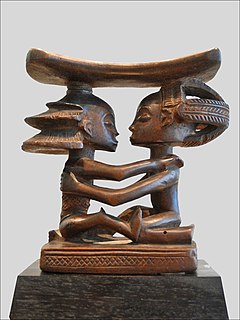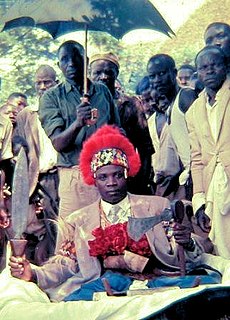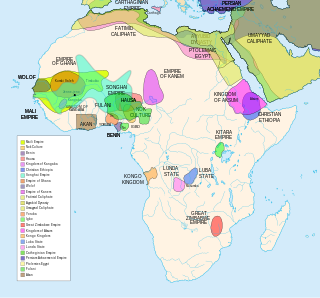
Central Africa is the core region of the African continent which includes Burundi, the Central African Republic, Chad, the Democratic Republic of the Congo, and Rwanda. Middle Africa is an analogous term that includes Angola, Cameroon, the Central African Republic, Chad, the Democratic Republic of the Congo, Equatorial Guinea, Gabon, the Republic of the Congo, and São Tomé and Príncipe. All of the states in the UN subregion of Middle Africa, plus those otherwise commonly reckoned in Central Africa, constitute the Economic Community of Central African States (ECCAS). Since its independence in 2011, South Sudan has also been commonly included in the region.
The pre-colonial history of the Democratic Republic of the Congo encompasses the political, economic and social history of the territory of the modern-day Democratic Republic of the Congo before the arrival of European colonial rule in the late 19th century.

The Luba people or baLuba are an ethno-linguistic group indigenous to the south-central region of the Democratic Republic of the Congo. Majority of them live in this country, residing mainly in its Katanga, Kasai, and Maniema provinces. The baLuba consist of many sub-groups who speak various dialects of Luba or other languages, such as Swahili.

Kazembe is a traditional kingdom in modern-day Zambia, Southeastern Congo. For more than 250 years, Kazembe has been an influential kingdom or chieftainship of the Kiluba-Chibemba, speaking the Swahili language or the language of the Eastern Luba-Lunda people of south-central Africa. Its position on trade routes in a well-watered, relatively fertile and well-populated area of forestry, fishery and agricultural resources drew expeditions by traders and explorers who called it variously Kasembe, Cazembe and Casembe.

The Nation of Lunda was a confederation of states in what is now the Democratic Republic of Congo, north-eastern Angola, and north-western Zambia, its central state was in Katanga.

The Lunda originated in what is now the Democratic Republic of the Congo along the Kalanyi River and formed the Kingdom of Lunda in the 17th century under their ruler, Mwata Yamvo or Mwaant Yav, with their capital at Musumba. From there they spread widely through Katanga and into Eastern Angola, north-western Zambia and the Luapula valley of Zambia.
The Lunda people of the Luapula River valley in Zambia and DR Congo are called by others the Eastern Lunda to distinguish them from the 'western' Lunda people who remained in the heartland of the former Lunda Kingdom, but they themselves would use Kazembe-Lunda or Luunda with an elongated 'u' to make that distinction..
Kanyembo is the principal centre of the population on the Mofwe Lagoon, the largest of several lagoons in the Luapula River swamps south of Lake Mweru, in the Luapula Province of Zambia. It takes its name from its traditional ruler, Chief Kanyembo, one of the senior chiefs of the Kazembe-Lunda under Mwata Kazembe. In the past the incumbent Chief has been promoted to Mwata, and Kanyembo was the site of Mwata Kazembe's capital when it was visited by David Livingstone in 1867.
Mwata Yamvo is the name of the 16th-century founding ruler of the Lunda Kingdom and the title given to all subsequent rulers or paramount chiefs of the Lunda people to the present day. The name has variety of spellings: Mwaant Yav, Mwaant Yaav, Muata Jamvo, Mwata Yamfwa.
The Bakwa Dishi is a people belonging to the Luba ethnic group living today in the Kasai-Oriental Province in the Democratic Republic of Congo. Miabi, the Dishi Capital, is located 16 miles (26 km) West of Mbuji-Mayi. The territory of the Bakwa Dishi lies on approximately 1,900 square miles (4,900 km2), which is known as the Miabi territory.
Ilunga Mbili was a soldier and cultural hero of the Luba and Lunda people.
Tshibinda Ilunga was a Luba Prince and Emperor of the Lunda and their civilizing hero.
Kongolo was a leader of Luba people in the region of Katanga, and the first king of the Luba Empire. He built his capital in Mwibele, near Lake Boya. Kongolo Mwamba was trying to extend his kingdom in conquering the Songye neighbouring chiefdoms.

The Kingdom of Luba or Luba Empire (1585–1889) was a pre-colonial Central African state that arose in the marshy grasslands of the Upemba Depression in what is now southern Democratic Republic of Congo.
Ilunga Sungu was a ruler (Mulopwe) of the Kingdom of Luba in what is now the Katanga Province of the Democratic Republic of the Congo. Based on oral records, he ruled from some time around 1780 to around 1810.

The Yeke Kingdom of the Garanganze people in Katanga, DR Congo was short-lived, existing from about 1856 to 1891 under one king, Msiri, but it became for a while the most powerful state in south-central Africa, controlling a territory of about half a million square kilometres. The Yeke Kingdom also controlled the only trade route across the continent from east to west, since the Kalahari Desert and Lozi Kingdom in the south and the Congo rainforest in the north blocked alternative routes. It achieved this control through natural resources and force of arms—Msiri traded Katanga's copper principally, but also slaves and ivory, for gunpowder and firearms—and by alliances through marriage. The most important alliances were with Portuguese–Angolans in the Benguela area, with Tippu Tip in the north and with Nyamwezi and Swahili traders in the east, and indirectly with the Sultan of Zanzibar who controlled the east coast traders.
The Ishindi-Lunda are an ethnic group living mainly in the North-Western Province of Zambia under Senior Chief Ishindi, around the provincial capital Zambezi. The Lunda people of North-Western Province consists of Kanongesha Lunda and Ishindi Lunda.
Lunda Lubanza traditional ceremony is celebrated by the Lunda people of senior Chief Ishindi during the month of August every year at Mukanda Nkunda in Zambezi district of the North-Western Province of Zambia.
Mwata or Muata may refer to the following people






